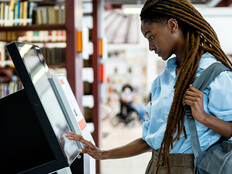Predicting the future may no longer be such a fantastical notion. The concept of digital twin technology is essentially what it sounds like: a virtual, real-time representation of a physical product or process.
Much more than a simulation, digital twin technology has evolved to use machine learning, virtual reality, augmented reality and mixed reality to replicate and monitor existing physical objects and processes — and to more accurately predict outcomes of particular scenarios.
DISCOVER: The difference between VR, AR and XR and how they can transform online learning.
What Is a Digital Twin?
Although the term “digital twin” became popularized in 2002 after a paper published by Michael Grieves, then a computer engineer at the University of Michigan, this concept of simulating a real-life asset was applied to achieve the successful and dramatic return of Apollo 13 back in 1970. At the time, NASA referred to this concept as “mirrored systems.”
Today, digital twin technology is an increasingly insightful and critical tool across many industries, including urban planning, healthcare and manufacturing. It’s also noteworthy that Amazon will soon launch its AWS IoT TwinMaker platform, which simplifies the creation of digital twins, and NVIDIA recently announced its vision to build Earth-2, an AI supercomputer that will create a digital twin of our planet to predict climate change.
Click the banner below for exclusive content about emerging technologies in higher ed.


Digital Twins Can Play a Role in Every Academic Field
In academia, the potential of exponentially enhancing the learning experience via digital twin technology carries into every field of study.
Medical students can perform dissections and analyses on virtual models of animal and human cadavers. Complex chemical and molecular modeling can be more accurately achieved and comprehensively studied by applying digital twin technology within a VR or AR experience.
At the same time, digital twin technology also introduces more personalized learning, allowing students to work individually at their own pace on projects that would have previously required a group setting.
91%
The percentage of Internet of Things platforms that will contain some form of digital twin capability by 2026
Source: Research and Markets, “Digital Twins Market by Technology, Twinning Type, Cyber-to-Physical Solutions, Use Cases and Applications in Industry Verticals 2022 – 2027,” March 2022
At Wichita State University, the National Institute for Aviation Research operates a Digital Twin Lab, which recently partnered with the U.S. Air Force to disassemble and digitally scan two F-16s to create a full-scale, 3D model of the aircraft. The four-year project will provide unique, hands-on learning opportunities in digital engineering for Wichita State students.
Dan Isaacs, Chief Technical Officer at Digital Twin Consortium, points out that as the pandemic has truly pushed us into the age of digital transformation, digital twin technology will help students to learn in a way that is unlike anything we’ve ever seen.
“You already see the adoption of digital twin technology,” he says. “You can only imagine what’s going to go on. It’s crazy: You won’t need a headset in the future. You’ll be able to walk into your room and say, ‘Which lesson do I want to go to now?’ You’ll start the class and visualize it. As the educator Edgar Dale stated, we remember 80 percent of what we personally experience. And this is the experiential learning that digital twin technology brings with AR, with VR, with the ability to visualize and do it in a collaborative manner.”
metamorworks/Getty Images











